Great grilled food starts with a good cooking grid. It’s the secret to sensational sear marks, that sought-after crusty exterior, and maximum grill flavor. If your cooking grid is rusted, warped or burned through in spots, it might be time to replace it. Here’s what you need to know if you’re in the market for a new one.
Why is a good cooking grid important?
Outdoor grilling almost always involves three types of heat energy to cook food: radiant – the infrared energy generated by a charcoal or gas fire that excites and heats the molecules within food; convection – the movement of hot air inside the closed hood of the grill; and conduction – when food comes in direct contact with a hot surface. Cooking grids are responsible for conduction cooking and are what makes grilling … well, grilling.
Most cooking grids are made from one of five materials – chrome-plated steel, porcelain-coated steel, cast iron, porcelain-coated cast iron, and stainless steel. Each offers distinct differences in durability, how they retain and transfer heat, how easy they are to clean and maintain, and how much they cost.
The bars within a cooking grid come in different shapes and thicknesses and can be spaced close together, wide apart or somewhere in between. The configuration of the grid can impact cooking performance almost as much as the material they’re made of.
HOT TIP: Wider bars on a cooking grid offer more surface area for contact with the meat. This creates more pronounced grill marks.
The five main cooking grid materials:
HOT TIP: To make those iconic, cross-hatch grill marks, rotate food a quarter turn halfway through the cooking time required on the first side. Then repeat the process on the second side.
A pound of prevention…
A little ongoing maintenance will help preserve your cooking grid for years to come, no matter the material or configuration. Whether you’re grilling filet mignon or a humble hot dog, it’s important to start with a clean, hot, oiled cooking grid.
For a complete list of replacement cooking grids, select your brand and model.
Lisa Mayer June 16th, 2015
Posted In: BBQ Maintenance, BBQing HowTos
Do you count the days between camping trips? Do you dream of golden roasted marshmallows? Do visions of crispy blackened sugar balls haunt your sleep? Well, my friend, there is a better way.
1 Pack of marshmallows
1 Block of chocolate; shaved, grated, chopped, (or cut into decadent slabs)
1 Packet of graham crackers, shortbread cookies, ginger snaps, (or Oreos twisted open, depending how sacrilegious you’re willing to get)
Just like you would at a campfire. Skewer the marshmallows. Hover them over the grill; close, but not too close.
A temperature of 500-600 F works perfect for me. I simply rotate the marshmallows over the heat for 30 seconds or so, and I’m done.
Slide the marshmallow(s) onto your cookie surface of choice.
Add some chocolate.
Properly squish it.
Eat.
And there you have it. S’mores in 30 seconds, at the end of every grilling session. Who needs camping?
David B. April 7th, 2014
Posted In: BBQing HowTos, Desserts & Fruit, Recipes
If you need an excuse to get out on the grill this Thanksgiving, here it is: Grilled Pumpkin. A savory treat that’s easy (provided you are careful cutting the pumpkin) and delicious.
Improvise as you like, pumpkin holds up well to lots of different flavors. Here’s a recipe to guide you.
1 Pumpkin (per 1 lb)
2 tablespoons smoked paprika
2 tablespoons olive oil
2 crushed garlic cloves
Preheat your grill / BBQ for medium-hot, direct grilling. Cut pumpkin into 1/2 inch thick wedges . Deseed
Tip: Leave the skin on so the pumpkin slices stay together. Trim off skin before serving if you like.
Mix paprika, olive oil and garlic in a bowl with the pumpkin.
Grill the pumpkin 3-5 minutes on one side, turn and cook until tender. The pumpkin slides should be fork tender.
David B. November 18th, 2013
Posted In: BBQing HowTos, Vegetables

Ideally, try to get grass raised sausages from a local butcher, or good supermarket. Look at the ingredients, are they filled full of fillers, and preservatives? Then there is a pretty good chance they be pretty tasteless. Make sure they’re uncooked, not precooked sausages too.
You can cook sausages indirectly or directly, but I think they taste best and are easiest, barbecued indirectly with the lid down.
Indirect grilling
If you were to bake sausages in the oven, you’d cook them at 350 degrees for 20 mins, and that’s exactly what you’d do with a barbecue. Set up your barbecue or grill for indirect grilling, at 350 degrees. Cut the sausages between the links, and place sausages on the grid with as much flamboyance as you can muster. Close the lid, and that’s it. Open it back up in about 20 mins. Exceptional grilled sausages.
Direct grilling
It’s more difficult to grill sausages directly, and you do have to tend and keep turning them, but it’s still pretty simple with practice.
The most common problem people have when grilling is to have the temperature too high. That normally means the sausages will burn on the outside before they cook completely in the middle. Or look great on the outside, but still pink in the middle.
Make sure you keep your sausages as far from the heat as possible and keep it turned way down. Just like the indirect method, you want to grill your sausages low and slow, turning frequently.
Whichever way you decide to cook them, it’s important to regularly keep an eye on the temperature of your sausages. They need to be at 160 degrees, any higher and they start to dry out quickly. Any less and they will be undercooked.
David B. September 13th, 2013
Posted In: BBQing HowTos

In May, I first wrote about cooking pizza on the BBQ. This is a follow up post of sorts. Truth be told, homemade pizza on the BBQ has quickly become a family meal in our home, and our go to meal for indulgence and piggery.
Barbecuing pizza is not in any way a gimmick (something that you wouldn’t normally do, but do because you just love grilling)–it produces genuinely fantastic results that are better most pizza restaurants. It’s impossible to get pizza as good in your home oven.
Pizza peel – to transfer to the hot stone on the BBQ
Pizza stone
A BBQ or gas grill with a lid capable of getting to about 500 – 650 degrees, ideally 600-650
You’ll also need some cornmeal to sprinkle on the pizza peel
1/2 cup warm water (110 degrees)
1 envelope instant yeast
1 1/4 cups water; at room temperature
2 tablespoons extra virgin olive oil
7.5 ounces of fine semolina flour (1 1/2 cups) + 14.5 ounces of bread flour (2 1/2 cups), OR 22 ounces bread flour (4 cups)
1 1/2 teaspoons of salt
Ingredients for a pizza are kind of like a sandwich; whatever you have at hand, or feel like on the day. Mozzarella, pizza sauce, pepperoni, ham, pineapple, salmon, cream cheese, mushroom, onion, etc!
My three pizzas were: ham and pineapple; salmon (pre-cooked in the frying pan), red onion, and cream cheese; mushrooms, kalamata olives, and feta cheese.
Step 1. Prepare the Yeast. Add the warm water into a 2 cup measuring jug. Sprinkle the yeast and let it stand for about five minutes, or until the yeast swells.
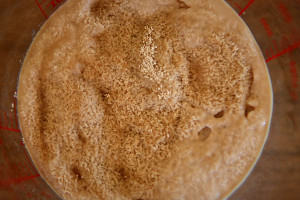
Step 2. Add the room temp water, and olive oil, and stir.
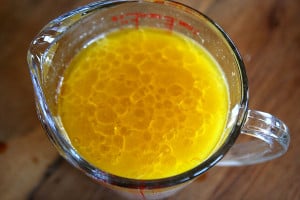
Step 3. Whizz the flour and salt in the food processor for 10 seconds. Add the yeast mixture while the food processor is running.
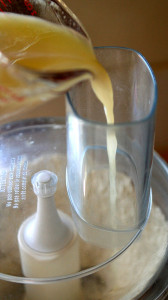
Step 4. Run the food processor until the mixture combines to a ball. Continue to process the dough for another 20-25 seconds. There will be a few stray pieces of dough (as pictured).

Step 5. Dump onto a floured prep surface and hand kneed a few times to finish off. The dough should be slightly elastic. Oil a large bowl, big enough for the dough to at least double in size. Add the dough and cover with plastic wrap. Put the dough somewhere warm for 2 hours, or until the dough doubles in size. Take a break, you’ll need to start preparing the BBQ and pizza toppings in about an hour.
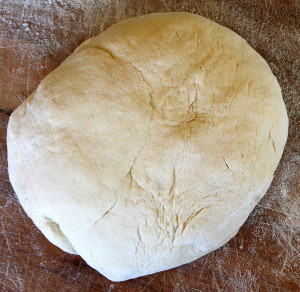
Step 7. Prepare the toppings, and crank up the BBQ. For the sauce I’ve simply been using two cans of good canned tomatoes. Season them well and cook them low and slow for about 30 minutes, or until pizza sauce consistency is reached. You want all of your pizza toppings prepared and ready at hand, so cook/take out of packing/wash everything. Everything needs to be done very quickly, and you won’t have time to mess around.
At about 90 mins into the dough rising, load up your coals, or start up your grill. Pop your pizza stone on the cooking grid and close the lid. You want to get your BBQ really hot, around 600-650 degrees. Great care is obviously necessary at these temps (even when opening the lid).
NB: Never put a cold pizza stone on a hot BBQ, always heat the BBQ up as you heat the stone up. Also don’t leave the pizza stone on top of the pizza grid after the BBQ has cooled. Moisture can be trapped between the grid and the stone and cause your grid to rust prematurely.
Step 8. After the dough has risen. Separate the dough out in thirds. Roll or stretch one third on a prepared surface and transfer to a pizza peel sprinkled with cornmeal.
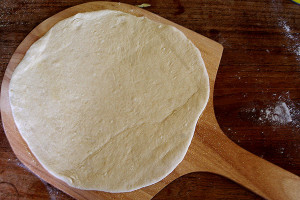
Step 9. Add your toppings
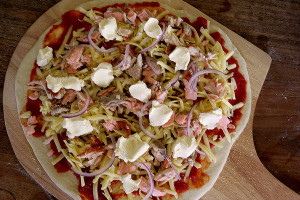
Step 10. Carefully transfer the pizza from the peel onto the pizza stone on the BBQ. Shut the lid as soon as possible and wait. Stay close to the BBQ and it wouldn’t be a bad idea at all to peak after just a couple of minutes to see how it’s going. It’s so easy to burn and a little heart breaking to have a fantastic looking pizza with a burned bottom. Here’s my ham and pineapple going on, yes I like a lot of pineapple on my Hawaiian pizzas.
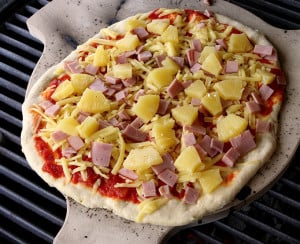
Step 11. Repeat for the other two pizzas, then eat.

David B. January 4th, 2013
Posted In: BBQing HowTos, Recipes
Planking is a great, easy way to grill; and is particularly suited to delicate foods like fish. The wood plank protects the flesh from the intensity of the flames or burners while imbuing it with delicious smokey flavors. However longer cooking meats like chicken will always pick up more smokiness since they’re exposed to the smoke for much longer.
And planking isn’t only for those cooking with charcoal, this technique works perfectly on gas grill as well!
You can use a variety of timber for planking, cedar isn’t the only option. Apple, alder, hickory –just be sure the wood isn’t treated!
Before grilling, the wood needs to be soaked it in a tub of water for at least an hour (to reduce the chance of it catching on fire). For another layer of flavor try adding a cup of juice or a splash of bourbon to the soaking water.
After soaking, put the plank on a preheated medium grill for a couple minutes on each side. You want the plank to be smoking and cracking before you put your food on it –this will make sure you get the maximum smokey flavor.
Now you’re ready to cook! Brush some oil on the hot plank, and put your food directly on it. No turning needed. Be sure to keep the lid closed as much as possible since a lot of the flavor from planking comes from the smoke.
A few other notes:
Be sure to keep a spray bottle on hand while cooking on a plank. The wood can catch fire, you need to be able to quickly extinguish any flare-ups.
Even though salmon is the traditional planking food, don’t limit yourself. Pretty much any fish is delicious cooked in this way. Also chicken, pork loins, vegetables. Really, anything you’d cook over an indirect heat. Marinate and season as you’d like, then cook it on the plank.
Cedar planks can be reused a number of times, as long as there is wood left. Depending on the length of cooking, I would expect around three uses. Don’t forget to soak it before each use.
Be sure to remove the plank as soon as you’re done cooking, otherwise the wood will just burn up. And if you’re using a gas grill, it will make a big mess in your burners.
Sauce:
1/4 cup pineapple juice
1/3 cup soy sauce
2 tablespoons apple cider vinegar
2 tablespoons lemon juice
1 tablespoon olive oil
3/4 cup honey
1/4 cup brown sugar, packed
1/2 teaspoon cayenne pepper
1/2 teaspoon paprika (Preferably hungarian paprika. Try smoked paprika for an even bigger punch. Or even smoked spicy paprika.)
1 garlic clove, minced
Freshly ground black pepper (about a teaspoon)
6 salmon filets, skinless and boneless
Salt
Freshly ground black pepper
2 cedar planks
Directions:
Prepare the planks as above.
Preheat the grill, medium heat.
Put the juice, soy sauce, vinegar, lemon juice, oil, and honey in a small saucepan and bring to a simmer over med-high heat. Reduce to med-low and stir in the rest of the sauce ingredients, cooking until it has reduced to and coats a spoon. About 20 minutes. Remove from the heat.
Sprinkle the salmon filets with salt and pepper
Your cedar planks should be finished soaking and be ready to put on the preheated grill. Leave them for a couple of minutes over the burners, until they start to smoke, then brush them with oil and pop the salmon filets on top. Close the lid, cook for 5 minutes, then spread a little of the sauce over the salmon. Put the lid back on and cook another 5 minutes. Apply another layer of glaze to the fish. Cook another 5 minutes or until the fish is opaque throughout.
Serve with the rest of the sauce, and enjoy. 
David B. September 3rd, 2012
Posted In: BBQing HowTos, Meat Poultry & Fish, Recipes
Grilling a pizza is one of those things that I’ve always planned to get around to.. in the future. Maybe it was the tinge of weirdness, or additional steps required after making a pizza by hand, but I’ve always decided to do it a different day, or a different occasion. Procrastination aside, I finally started trying to grill pizzas over the last few weeks, and it’s been a revelation. Not of divine proportions, but probably about as close as you could get from a pizza lover. The fantastic thing about cooking pizza on the grill is you can get the pizza to a much higher temperature than a conventional oven. You also get a smokey, barbecuy taste that can’t be matched.
Grilling is always an imperfect science at the best of times. Getting the condition right for your particular grill or barbecue takes time. We had a few disasters here, quite a few.. 2 totally burnt pizzas, a dropped pizza (that one almost ended in tears), and a few that still tasted good but I knew could be better. So don’t despair, it’s worth the persistence, well worth it!
Because the pizza cooks so fast, and the heat can be very very hot, we’ve found you get more consistent results with a thin base and thin toppings. Feel free to experiment.
Using a gas grill: Make sure your burners are in tip top shape, and not producing any hotspots Using a charcoal bbq: Keep your coals even across the span of the pizza stone.
There are two schools of thought with grilling pizzas. One is to cook your pizza straight on the grid with an indirect heat source. The other is to use a pizza stone. Using a pizza stone tended to even out the heat a lot better, reduced the risk of burning the pizza, and of course you can compile the pizza in the kitchen rather than on the grill itself.
This recipe is great on the grill. It makes 2-3 pizzas depending on the size of your pizza and how much pizza dough is stolen. I tend to split the pizza dough in thirds, use one, and wrap the other two separately with lots of plastic wrap and store it in the fridge.
1/2 cup warm water (110 degrees)
1 envelope instant yeast
1 1/4 cups water; at room temperature
2 tablespoons extra virgin olive oil
22 ounces bread flour
1 1/2 teaspoons of salt
1. Sprinkle yeast onto the warm water for about 5 minutes. Then add the room temperature water and olive oil.
2. Mix the flour and salt in a food processor. Pulse the food processor while adding the liquid ingredients from step 1. Process until dough comes together, and is smooth and stretchy.
3. Dump out onto a floured work surface. Kneed briefly to form a ball.
4. Put the dough into a large oiled bowl and cover with plastic wrap. Let rise in a warm place, 1/2 to 2 hours.
This sauce is exceptionally simple, and works best with fresh tomatoes, but you could use canned.
1 lb tomatoes
1 Tbsp Olive oil
2 cloves garlic
Salt to taste
1/4 cup good bbq sauce, such as Grumpy’s Goodnight Lovin’
1. Heat a saucepan over medium heat and add the Olive oil and garlic for 30 seconds, being careful not to burn it.
2. Add in the tomatoes and simmer until the tomatoes melt down and thicken, about 20 minutes
4 oz Mozzarella, shreaded or cut half inch thick
8 oz Pepperoni, peeled and thinly sliced
That’s it. You could do whatever you want for a topping and sauce, but remember, be spartan: less is more, especially on the grill.
1. You want an even heat distribution over your grill. If you’re using gas, turn on all burners, if charcoal, spread coals evenly across the bbq. Put the stone in when the grill is still cold, and close the lid for it to preheat (about 20 minutes depending on your grill).
2. Sprinkle semolina or cornmeal onto a pizza peel, then place your pizza dough onto the peel. If you don’t have one, you might need to improvise a little.
3. Add the sauce, and toppings.
4. Take the pizza peel over to the grill and slide the pizza onto the pizza stone.
5. Cooking times vary greatly but you want to take the pizza off when the crust starts browning in spots, about 5-10 minutes. Be sure not to leave it unattended as it can go from delicious looking to a burnt mess in minutes (from experience).
David B. May 2nd, 2012
Posted In: BBQing HowTos, Recipes
Make sure your grill is super clean. Any residue will cause the fish to stick.
Preheat the grill until it is very hot before putting the fish on.
Coat the fish very thinly with oil before cooking.
After you set the fish on the hot grill, leave it there! Don’t move it for at least a couple of minutes. This will give it time to sear and separate from the grill. When you do move it, wiggle it carefully and then roll it over.
David B. March 25th, 2011
Posted In: BBQing HowTos, Meat Poultry & Fish

Using a meat thermometer is the best way to cook the chicken to perfection. Chicken thighs should be cooked to 165 degrees Fahrenheit and chicken breast should be cooked to 160 degrees. Make sure the thermometer is inserted into the thickest part of the chicken and not touching any bones.
Brining improves the chicken’s flavor making it juicy and deliciously tender. However, if you’re short on time, skip this step and season the chicken generously with salt and pepper before cooking.
Important Note: Chicken that has been brined browns faster and you’ll need to careful it doesn’t burn.
Simple brine recipe:
Dissolve salt into water in a gallon zip-lock bag. Add chicken, remove air and seal. Refrigerate for about 1.5 hours.
Rubs give plenty of flavor without the burning risk of BBQ sauces. As much as we love BBQ sauce, and we really do… it’s best applied in the last couple of minutes as a general rule.
Apply the rub generously to all the chicken pieces, try to run as much under the skin as you can.
Simple spice rub:
The sugar in BBQ sauce will cause it to burn if it’s applied too early. You want to smother the chicken in the sauce during the last 2 minutes of cooking. Bush the chicken with sauce, cook for about 1 minute, turn over, brush again and cook 1 more minute. Before serving, brush the chicken with more BBQ sauce. I like to have even more sauce at the table for dipping.
You should plan on using about 1/2 cup of BBQ sauce for about 8 thighs (not including any sauce you have at the table).
This creates a delicious browned exterior while keeping the inside from over cooking.
Set up the Grill with one side on High and the other on Med-Low, or bank the coals mainly on one side for a charcoal BBQ.
Starting on the hot side of the grill, sear the chicken for 1 to 2 minutes on each side. Be very vigilant during this period, you don’t want the chicken to burn, and if you get any flare ups, move the chicken to a different area of the grill.
Move the chicken pieces to the side with lower heat and finish cooking. If you’re cooking chicken breast it works best to close the lid, this helps the interior cook faster, so it is done before the exterior starts to burn.
David B. December 13th, 2010
Posted In: BBQing HowTos
Next time you are going to cook some sausages on the BBQ, why not try hot smoking. It’s really easy to do and can be mastered quickly. There are lots of different ways to do it, and you can really get creative. Â Different woods can impart a lot of different flavors. Hot smoking tend to make sausages look fantastically mouth watering and smell irresistible.
Fresh sausages are known to be tough to cook without either drying them out or under cooking them. The trick is to cook them indirectly and use an instant read thermometer to keep an eye on them.
One of the best things about a Charcoal Kettle-Style BBQ like a Weber BBQ is the ability to throw the lid on it and smoke-out your food. That’s why I typically keep two BBQs on hand (figuratively), a normal gas grill, and a charcoal grill. You can still smoke on a regular gas grill though, so don’t feel limited to what you see here, let your creative juices flow.
Hot smoking is best when you use an indirect heat. You can do this easily with a charcoal BBQ by moving he coals to opposite sides of the  BBQ, or by only turning only one burner on with your gas grill BBQ.
– Soak your wood chips. The amount you need is going to depend how long you intend to smoke and type of wood chips, but roughly – a couple of handfuls. They should soak for a minimum of 30 mins.
– Light the charcoal.
– Once it is hot (about 20-30 mins), split it into two piles at opposite ends of the BBQ.
The charcoal chimney we used here is recommended purely because of the way it heats the charcoal up to an even temperature. You could easily make a pile though if you don’t have one handy.
– Remove the cooking grid, throw the wood chips on top of your charcoal, and replace the cooking grid. I do like to add wood chips occasionally throughout the smoking, but make sure to be generous at first, as the wood chips are most effective before the meat is fully cooked
– Put the sausages onto the middle of the cooking grid. If you put the sausages too close to the sides they will overcook.
– Close the BBQ and resist the urge to peak too often. Open the vent half-way.
– Take the sausages off the BBQ when they reach an internal temperature of 150 degrees.
– Enjoy.
David B. October 20th, 2010
Posted In: BBQing HowTos